Sundadanio axelrodi
Classification
Cyprinidae
Distribution
Supposedly native to the Greater Sunda Islands of Borneo and Sumatra as well as the Riau Archipelago and Bangka Island off the east coast of Sumatra but the only collection/locality details we have been able to find refer to Bornean populations. Numerous records also exist from the Indonesian provinces of West Kalimantan (Kalimantan Barat), Central Kalimantan (Kalimantan Tengah) and South Kalimantan (Kalimantan Selatan) but the species appears not to occur in the north of the island.
It exists in several colour forms depending on locality; fish from the south and east of Sarawak state in Malaysian Borneo are green/blue in colour while those found in the west are red/orange, for example. It would be useful if these variants were labelled with the collection details by hobbyists and scientists alike in order to preserve bloodlines and maintain greater accuracy although normally they are just labelled with the distinguishing colour eg. ‘red’, ‘green’ or ‘blue’.
Habitat
Inhabits black water streams and pools associated with ancient forest peat swamps. The water is stained brown due to the release of tannins and other chemicals released by decomposing organic matter and the substrate scattered with fallen leaves, twigs and branches. Such environments characteristically contain very soft (negligible hardness), acidic (pH as low as 4.0) water and are often dimly-lit due to the forest canopy above and dense marginal vegetation. Across much of Southeast Asia these precious biotopes are under threat from rubber/palm oil plantations, building developments and other human activities.
Maximum Standard Length
20 – 22 mm.
Aquarium SizeTop ↑
A group can be housed and will breed in a tank with dimensions of only 12″ x 8″ x 8″/30cm x 20cm x 20cm/12.5 litres although water quality may become an issue unless strictly monitored. We think something measuring around 18″ x 10″ x 10″/45cm x 20cm x 20cm/29.5 litres or more is preferable for long-term care.
Maintenance
Best kept in a densely-planted tank and is an excellent choice for the carefully-aquascaped set-up. The addition of some floating plants and driftwood roots or branches to diffuse the light entering the tank also seems to be appreciated and adds a more natural feel. Filtration does not need to be particularly strong as it mostly hails from sluggish waters and may struggle if there is a fast current.
To see it at its best a biotope-style set-up can also make an interesting project. A soft, sandy substrate is probably the best choice to which can be added a few driftwood roots and branches, placed in such a way that plenty of shady spots are formed. If you can’t find driftwood of the desired shape common beech or oak is safe to use if thoroughly dried and stripped of bark.
The addition of dried leaf litter (beech, oak or Ketapang almond leaves are all suitable; we like to use a mixture of all three) would further emphasise the natural feel and as well as offering even more cover for the fish brings with it the growth of microbe colonies as decomposition occurs. These tiny creatures can provide a valuable secondary food source for fry whilst the tannins and other chemicals released by the decaying leaves are thought to be beneficial for blackwater fish species such as this. Leaves can be left in the tank to break down fully or removed and replaced every few weeks.
Allow the wood and leaves to stain the water. A small net bag filled with aquarium-safe peat can also be added to the filter or hung over the edge of the tank to aid in the simulation of black water conditions. Alternatively obtain some genuine peat fibre and simply drop a few handfuls into the tank. This will become completely saturated with water after a few days and sink to the bottom where it can look really effective. Provided a good routine of water maintenance is practiced no adverse effects should occur using either peat or leaves in an aquarium.
Fairly dim lighting should be used to simulate the conditions the fish would encounter in nature. You could add some aquatic plants that can survive under such conditions such as Microsorum pteropus, Taxiphyllum barbieri or Cryptocorynes, and a few patches of floating vegetation would be really useful to diffuse the light entering the tank too. Note that this fish should not be added to a biologically immature tank as it can be susceptible to swings in water chemistry and a regime of regular, small (10% or less of tank volume) water changes is recommended in order to minimise stress.
Water Conditions
Temperature: 73 – 79°F/23 – 26°C
pH: Requires strictly acidic conditions within the range 4.0 – 6.5.
Hardness: 0 – 5°H
Diet
Presumably feeds on small aquatic crustaceans, worms, insect larvae and other zooplankton in nature. It can be a little picky in the aquarium and may not accept dried foods although in some cases they will learn to take them over time. At any rate they should always be offered regular meals of small live or frozen fare such as Artemia nauplii, Daphnia, grindal, micro and chopped bloodworm in order to develop ideal colour and conditioning. Newly-imported specimens are often in poor condition and can be difficult to acclimatise to aquarium life. Small live foods are therefore recommended as an initial diet, with dry and frozen products being introduced as the fish become settled.
Behaviour and CompatibilityTop ↑
It is very peaceful but does not make an ideal community fish due to its small size and rather timid nature. It will do best when maintained alone or with similarly-sized species that enjoy comparable water conditions such as Boraras, Eirmotus, Trigonostigma. If geography is not an issue we suspect it will also thrive alongside small South American characins such as Nannostomus anduzei, N. mortenthaleri, Paracheirodon simulans, Hyphessobrycon amandae or perhaps Lepidarchus adonis from western Africa.
It’s a schooling species by nature and really should be kept in a group of at least 20-30 specimens. Maintaining it in decent numbers will not only make the fish less nervous but will result in a more effective, natural-looking display. Males will also display their best colours and some interesting behaviour as they compete with one other for female attention. We don’t advise mixing the different colour forms though as unnecessary hybridisation might occur.
Sexual Dimorphism
Externally, mature males are more colourful and noticeably slimmer than females. In some colour forms they also exhibit dark colouration in the anterior portion of the anal fin whereas in others the same area is red, while females have a colourless anal fin. This species also exhibits unique dimorphism in musculature and structure of the pectoral girdle, skeleton and Weberian apparatus, allowing males to produce audible croaking/chirruping sounds when stressed (Conway and Britz, 2007). These can be heard when the fish is removed from the water (highly unrecommended; see ‘notes’ section) or in the aquarium during dominance battles between rival males. The authors hypothesised that the sounds are produced either by grinding the modified 5th pectoral fin ray against the cleithrum or using the “bulbous” muscle tissue like a drum. Such adaptations are thought to be unique among the Teleostei group of ray-finned fishes and may be involved in both sexual and hierarchical display behaviour.
Reproduction
This species has not been bred often in the hobby which is probably down to the fact it does not appreciate fluctuating water conditions, making it difficult to arrange separate spawning/rearing tanks. Reports do exist, however, and the greatest successes have been when the adult fish are maintained alone as a good-sized group in heavily-planted, mature aquaria. The pH should ideally be below 6.0 with other parameters within the ranges suggested here, the most important factor being that they remain stable. The simulation of blackwater conditions using leaves and real peat fibre is thought to be highly beneficial due to the microorganisms which proliferate in such set-ups. Bright lighting is best avoided, however. Feed the fish with plenty of live and frozen foods and they should come into spawning condition, and if the tank contains the requisite balance between cover, water conditions and microfauna fry should start to appear without further intervention.
NotesTop ↑
This species was initially described as Rasbora axelrodi and is referred to as such in older literature, but in 1999 was moved into the new genus Sundadanio where it remains the monotype. Its wider placement within the family Cyprinidae is still not fully resolved. Following Rüber et al. (2007) it is most closely-related to the miniature species of the genus Paedocypris, the two genera characteristically lacking bones in the roof of the skull as well as exhibiting genetic similarities. However in some tests conducted during phylogenetic studies by Mayden et al. (2007) and Fang et al. (2009) it was unexpectedly recovered as the sister group to the subfamily Cyprininae, which includes such genera as Puntius, Garra, Epalzeorhynchos, Labeo, Carassius and Sawbwa. In others it occupied a position within the Danioninae being recovered variously as sister to Danionella (by Mayden et al.) or Paedocypris (by Fang et al./Rüber et al.). Based on current knowledge the latter placement seems the more likely, and there are some shared morphological aspects of the lower jaw between Sundadanio and other danionins which further imply their relatedness.
Its small adult size evolved via a process known as miniaturisation characterised by sexually mature adults with a significantly reduced size of less than 20mm SL. Among bony fishes cyprinids are one of the few groups in which this phenomenon occurs repeatedly with all Barboides, Danionella, Microdevario, Microrasbora, Horadandia, Boraras, Paedocypris, Sawbwa and Sundadanio species representing miniaturised taxa along with a few members of Danio, Laubuca and Rasbora. All show a preference for still or slow-moving waters, often in nutrient-poor habitats such as forest peat swamps.
The anatomical structure of miniaturised cyprinids can vary greatly; there are two principle ‘groupings’ with some species possessing intermediate features to some degree. The first contains those fishes which though small are essentially proportionally dwarfed versions of their larger relatives e.g. Barboides, Microdevario, Microrasbora, Horadandia, Boraras, Sawbwa, Sundadanio, Danio, Laubuca and Rasbora.
The other includes those in which anatomical development stops at a point where adult still resemble a larval form of their larger ancestor i.e. Danionella and Paedocypris. The latter are usually referred to as ‘developmentally truncated’ or ‘paedomorphic‘ and are thought to have evolved via a process known as ‘progenetic paedomorphosis’ i.e. paedomorphosis brought about by accelerated maturation. They typically exhibit a simplified skeletal structure along with species-specific morphological peculiarities such as the tooth-like projections in male Danionella dracula. Britz et al. (2009) consider that developmental truncation may have facilitated the development of such novelties “by freeing large parts of the skeleton from developmental constraints, dissociating developmentally linked pathways and creating a greater potential for more dramatic changes”.
Take note that S. axelrodi does not react well upon being exposed to the air. When transporting the fish try to transfer it to the bag or container underwater if possible, and any net used should be of the softest, finest grade available. Acclimatisation is best done slowly using a drip-method or similar. It is not really a good choice for newcomers to the hobby as it requires rather stringent water conditions but is not difficult to keep provided these needs can be met.
References
- Conway, K. W. and R. Britz. 2007 - Journal of Fish Biology 71: 1562-1570.
Sexual dimorphism of the Weberian apparatus and pectoral girdle in Sundadanio axelrodi (Ostariophysi: Cyprinidae). - Fang, F., M. Norén, T. Y. Liao, M. Källersjö and S. O. Kullander. 2009 - Zoologica Scripta, v. 38 (no. 1): 1-20.
Molecular phylogenetic interrelationships of the south Asian cyprinid genera Danio, Devario and Microrasbora (Teleostei, Cyprinidae, Danioninae). - Liao, T. Y., Kullander, S. O. and F. Fang. 2009 - Zoologica Scripta Early View (Articles online in advance of print).
Phylogenetic analysis of the genus Rasbora (Teleostei: Cyprinidae). - Mayden, Richard L.; Tang, Kevin L.; Conway, Kevin W.; Freyhof, Jörg; Chamberlain, Sarah; Haskins, Miranda; Schneider, Leah; Sudkamp, Mitchell; Wood Robert M.; Agnew, Mary; Bufalino, Angelo; Sulaiman, Zohrah; Miya, Masaki; Saitoh, Kenji; He, Shunping. 2007 - J. Exp. Zool. (Mol. Dev. Evol.) 308B: 1–13.
Phylogenetic relationships of Danio within the order Cypriniformes: a framework for comparative and evolutionary studies of a model species. - Rüber, L, M. Kottelat, H. H. Tan, P. K. L. Ng and R. Britz. 2007 - BMC Evolutionary Biology, 7, 38.
Evolution of minituarization and the phylogenetic position of Paedocypris, comprising the world's smallest vertebrate. - Rüber, L. , M. Kottelat, H. H. Tan, P. K. L. Ng and R. Britz. 2007 - BMC Evol. Biol. London. 7: [1-10].
Evolution of miniaturization and the phylogenetic position of Paedocypris, comprising the world's smallest vertebrate.

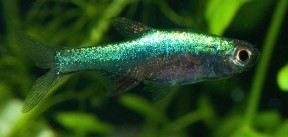
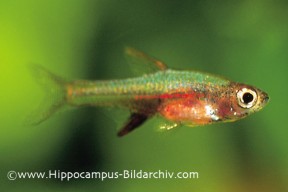
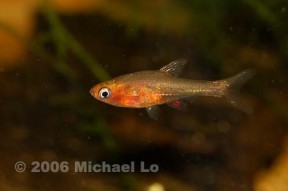
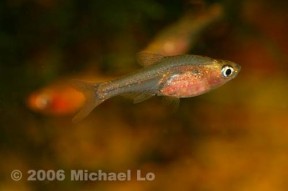
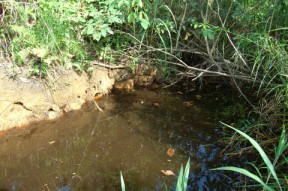
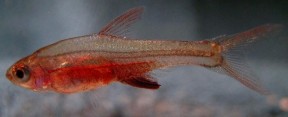
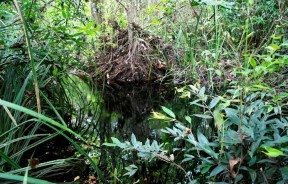
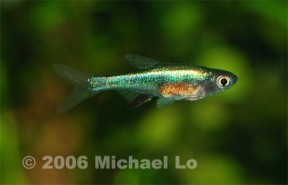

December 12th, 2018 at 6:57 pm
I’ve been keeping fifteen blue axelrodi (currently going under the name of S. goblinus) for about two months in a moderately planted 55 gallon SE Asia biotope tank. Other residents include pearl gourami, pentazona barb, harlequin rasbora, panda garra, and dwarf chain loach.
I find this species not at all timid. Despite dense planting in many areas of the tank, the goblinus are always in the open. Even when the pearl gouramis swim through the middle of them, they are not intimidated. They do not school tightly, but they do all hang out together. They do seem to prefer the stiller parts of the tank. Mine can almost always be found in a certain foot-square open area of the tank.
Goblinus seems very prone to ich. During a recent outbreak, this species was especially hard hit. I was able to get them through with no losses, but it was ugly.
Overall, these are wonderful little fish. From across the room, they look like little, blue sparks swirling around the tank. Up close, they are strikingly bright blue above, contrasting with deep maroon under the lateral line. I hope that someone figures out how to breed these little guys in captivity.
Thanks for all you do!
WB